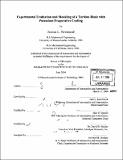Experimental evaluation and modeling of a turbine blade with potassium evaporative cooling
Author(s)
Townsend, Jessica Lee
DownloadFull printable version (11.00Mb)
Other Contributors
Massachusetts Institute of Technology. Dept. of Aeronautics and Astronautics.
Advisor
Jack L. Kerrebrock.
Terms of use
Metadata
Show full item recordAbstract
A new method of turbine blade cooling, the Return Flow Cascade, has been developed in which vaporization of a liquid metal such as potassium is used to maintain the blade surface at a nearly uniform temperature. Turbine blades cooled using this technology have lower blade temperature levels compared to that available with conventional air cooling, potentially resulting in higher firing temperatures or a choice of a wider range of materials for the hot gas path. The detailed operation of the Return Flow Cascade is described including fluid mechanic and heat transfer phenomena that occur at high heat flux and gravitational acceleration levels characteristic of modern gas turbine engines. The performance limits of the Return Flow Cascade are identified by the development of a theoretical model that estimates the performance of the system for a range of operating conditions found in the experimental test rig and in an actual gas turbine engine. These limits include vapor choking in the internal blade passages, pool boiling limits in the blade, and surface tension restriction of liquid flow. Experimental results are presented from testing in the Rotating Heat Transfer Rig at the Massachusetts Institute of Technology. An infrared detector capable of high scan rates was used to fully map the temperature distribution of a single, heated, rotating turbine blade. The blade surface temperature maps show that the Return Flow Cascade works as designed by enforcing a nearly constant temperature over the surface of the blade. Cascade initiation limits predicted by the internal vapor choking model are in good agreement with the test data.
Description
Thesis (Ph. D.)--Massachusetts Institute of Technology, Dept. of Aeronautics and Astronautics, 2004. Page 148 blank. Includes bibliographical references (p. 145-147).
Date issued
2004Department
Massachusetts Institute of Technology. Department of Aeronautics and AstronauticsPublisher
Massachusetts Institute of Technology
Keywords
Aeronautics and Astronautics.